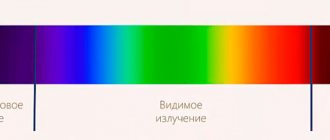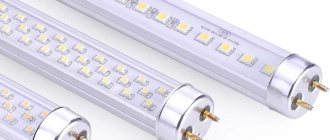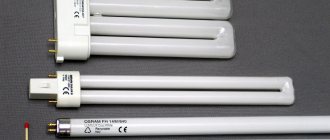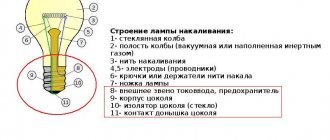Energy-saving or, as they are also called, compact fluorescent lamps have recently become very widespread due to their low electricity consumption, availability, and ease of use. After all, if the lamp had an incandescent lamp or halogen lamps, you just need to replace it with a CFL, and nothing else is required. In addition, the durability of such lighting devices is tens of times greater.
Many argue that such lighting negatively affects human health in general and vision in particular, but still the majority of people consider such lighting to be safe.
So are energy-saving lamps harmful to human health? In order to answer this question, it is necessary to understand the principle of operation of energy-saving light bulbs.
Scope of use
Fluorescent lamps are common and economical light sources that create diffuse lighting in public spaces. They are used in offices, schools, hospitals, shops and banks. With the advent of compact lamps, which are installed in standard E27 or E14 sockets instead of incandescent lamps, they have become in demand in domestic conditions.
Using ballasts instead of conventional electromagnetic devices improves the performance of lamps - helping to eliminate flicker and hum, and also increase efficiency. Fluorescent light bulbs have high luminous efficiency and long operating time.
Pollution instead of saving
The situation is aggravated by the fact that compact fluorescent lamps are not designed to be switched on and off frequently. That is why they were used historically in public places, where they burned almost constantly: their predecessor, in fact, are the so-called “fluorescent lamps”.
When turned on, fluorescent lamps introduce significant high-frequency interference into the power supply network. And this “pollutes” even more from the point of view of electromagnetic ecology our already crammed homes with technology. In addition, a large number of simultaneously switched on fluorescent lamps creates current flow conditions in the electrical networks of a building for which these networks are not designed, which can become a threat to electrical safety.
Pros of lamps
For those who want to save on electricity, it is important to know about the benefits and harms of fluorescent lamps. The main advantage is considered to be a reduction in energy costs, which are constantly becoming more expensive. Professionals have even carried out experiments regarding consumption of 80% less than with incandescent light bulbs.
Another advantage is durability. The product costs about 5 times more, but will last 10-12 times longer. This is beneficial, but each person must decide for himself whether to take it or not. But the health hazards from fluorescent lamps should also be taken into account.
Cancer
As scientists from the USA have established, the concentration of ultraviolet radiation from a light bulb is harmful to human health. This negatively affects the skin, leading to early aging, and sometimes to melanoma and skin cancer. Manufacturers of such products believe that ultraviolet radiation is generated during operation, but believe that the radiation is normal.
But as can be seen from the research results, the coating of the product has many microcracks, which increase the dose of ultraviolet radiation. In addition to cancer, the following are likely to occur:
- Allergies.
- Eczema.
- Psoriasis.
- Tissue swelling.
According to medical experts, the use of such light bulbs can lead to attacks of epilepsy, migraines, and deterioration of tone. Currently, two types of products are used: collagen and fluorescent. The second type is more harmful. Do not use 100 watt fluorescent lamps. If there are such light sources, then they must be replaced with lower power.
Possible risks from CFL light
The harm of fluorescent lamps, of course, has already been proven, but what is it? First, you need to list all the possible diseases that can be caused by radiation from energy-saving lamps, and then consider in more detail each of them and the reasons that cause them. So, the main risks:
- cancer, epilepsy and migraine;
- blindness;
- radiation poisoning.
Now it makes sense to understand why exactly an energy-saving lamp is harmful to human health and what can cause such serious complications.
Cancer, epilepsy, migraine
Here the danger comes precisely from ultraviolet radiation passing through microcracks in phosphor and glass. The volumes that fall on a person during the operation of such lighting devices are quite sufficient to damage skin cells, which subsequently leads to their death. Hence premature aging and the risk of melanoma, although the manufacturer claims that the phosphor layer prevents radiation from escaping. And yet, research has proven both the presence of microcracks and dangerous doses of ultraviolet radiation.
For the same reason, brain cells begin to die. The first signs of this are frequent headaches, later migraine attacks, and in more serious cases, epileptic seizures.
Blindness
Lighting with CFLs can cause eye diseases.
Those lamps that consume less electricity than others have a very strong effect on vision. As a result of research, it turned out that in recent years the number of eye diseases has sharply increased in those who are constantly exposed to the light of these lamps.
The fact is that in order to obtain white color, a certain composition is used, the properties of which are similar to ultraviolet radiation. In this case, the main blow falls on the retina, which is very sensitive to it. It is precisely when such light comes into contact with the eyes for a long time (as during the working day) that it causes oxidative processes in the mucous membrane.
Radiation poisoning
It is well known that mercury is a radioactive heavy metal, and it is its vapor that is found inside the fluorescent tube. Of course, there are specialized services for recycling such lamps, but the cost of such a service is very high, and 90% of those who use such devices simply dispose of them as household waste. Naturally, in the process, these lamps break and harmful vapors enter the atmospheric air, which is breathed by everyone who is nearby.
On the street, of course, the concentration of toxic substances is not so high. But sometimes energy-saving lamps explode during operation, and this happens directly in the room. And then this cannot happen to the human body without consequences; it will be dealt a severe blow.
One lamp contains about 7 micrograms of toxic substance per 1 cubic meter of air. And this despite the fact that the officially maximum permissible level is 0.35 micrograms.
Naturally, the nervous system, liver, kidneys and lungs take the brunt.
If the following symptoms appear, you should consult a doctor immediately:
- the appearance of a metallic taste in the mouth;
- headaches that are more similar to migraines;
- bleeding gums;
- dry cough;
- hand tremors;
- chills or fever.
If such symptoms appear suddenly, this is mercury vapor poisoning, and you should not joke about it.
Mercury is a radioactive metal
Poisoning
The dangers of fluorescent lamps are associated with the presence of mercury. During the manufacture of products, a phosphor, argon gas with mercury vapor is used. Great harm is expected from a broken fluorescent lamp, since indoors the indicator of these components will exceed the norm.
Risk areas for mercury poisoning include:
- Pregnant women.
- Babies.
- Small children.
- Old men.
If a fluorescent lamp breaks, there will be severe harm to human health. In this case, it is necessary for a special service to handle waste disposal. And for people who were in the room, you need to call a doctor.
Recommendations
If you still want to use energy-saving lamps, then you need to make every effort to reduce the harm from their use. Remember a few simple rules:
- install lamps exclusively on ceilings, do not use them in bedside lamps or table lamps, the distance to it is at least one meter;
- in case of mechanical damage, immediately ventilate the room;
- put on rubber gloves and use your hands to collect the fragments with drops of mercury (the latter can be collected using a pipette);
- no need to use a broom or vacuum cleaner for this purpose;
- then perform wet cleaning;
- place the rag with mercury and the fragments in a sealed bag;
- Disposal occurs in specially designated areas for toxic waste.
We believe that the danger of energy-saving lamps affecting human health is more than real. But a few simple recommendations, your vigilance, adherence to operating dates and no attempts to save money on the purchase of such products significantly reduce the risk of developing diseases.
Radiation
The harm of a fluorescent lamp lies in electromagnetic radiation, which distinguishes it from a conventional incandescent light bulb. The permissible radiation limit is violated within a radius of 15 cm from the light source. Therefore, they should not be used in table and wall lamps, near which you have to stay for a long time.
The electromagnetic field is active when the light bulb is operating, which can lead to the appearance of:
- CNS disorders.
- Suppression of immune defense.
- Diseases of the heart and blood vessels.
Waves can complement other negative environmental factors, so they are harmful to health. With them, “dormant” chronic diseases awaken and protection against viral infections decreases.
Obvious disadvantages
Despite the fact that fluorescent lamps have a good set of advantages, using such daylight sources at home also has a lot of disadvantages. However, many of them can lead to deterioration in human health. It is worth mentioning here that the cost of such light bulbs is quite high. This minus ranks next after the harm that such products can cause to the human body. The negative aspects of using fluorescent lamps include:
Dermatitis
- presence of ultraviolet radiation. People with various skin diseases should be very careful with such light bulbs. Otherwise, dermatitis, eczema, pigmentation, psoriasis, etc. may appear. In critical cases, skin cancer may even develop. But to get such negative consequences, the light source must be used for a very long time;
- side aspects of the work - flickering or stroboscopic effect. This is another significant disadvantage in the operation of fluorescent lamps, which directly affects the visual system. The blinking speed of such a light bulb can reach 50 times per second. Such flickering is very painful for the eyes. They begin to water, visual acuity decreases and general eye fatigue increases. Flicker can also lead to distortion of the visual perception of objects;
Note! Flickering can be corrected by installing 2 or more products in the lamp. This will reduce visual discomfort and reduce damage to the eyes.
- lack of inertia. As a result, such lamps light up with a slight delay. It can also cause visual discomfort. In this situation, the eye muscles try to adjust the lens to the changing light/dark criterion and cannot always cope with this effectively.
Note! Even following all the rules for using the product will not help level out all of the above negative aspects. This will only minimize the harm, but it will still not be possible to completely eliminate it. The operation of such light bulbs is especially dangerous for young children whose visual system is at a developing stage. After a year of exposure to such a light source, children are diagnosed with decreased visual acuity and may even need glasses.
Effect on vision
Fluorescent lamps are known to be harmful to the eyes. This applies to light sources with LEDs. The reason for this is that the "daylight" light waves appear due to the use of blue and yellow diode. Blue radiation is harmful to the eyes and affects the retina. The risk zone includes:
- Children, because they are sensitive to the effects on the eyes of energy-saving devices. They do not have a formed crystal of the eyeball, and therefore there is no protection from ultraviolet radiation.
- Persons with macular degeneration.
- People during drug treatment.
These lamps are not suitable for residential premises
With the correct selection of energy-saving lamps, you will not feel the difference. Energy-saving lamps have two characteristics:
- Color rendering index
- Colorful temperature
Color temperature from 2700 K to 3500 K is close to daylight, from 3600 K to 4600 K have a cold (bluish) tint.
The color rendering index of energy-saving lamps ranges from 60% to 98%. The higher this number, the better.
Usually on the lamp base there is a marking of three numbers, for example: 827 or 735. 827 means that the lamp has a color rendering index of 80%, a color temperature of 2700 K. 735 means that the lamp has a color rendering index of 70%, a color temperature of 3500 K.
Disposal
1 light bulb contains 7 mg of mercury. Although the indicator is small, you cannot throw it in the trash. Since the harm of fluorescent lamps is obvious, the manufacturer advises recycling failed energy-saving devices. This work is carried out by district departments:
- Directorate for Building Operations (DEZ).
- Repair and maintenance departments.
But as you can see from practice, such light bulbs end up in landfills. Manufacturers advise finding a company that disposes of mercury waste and entering into an agreement with it. But these services are paid, and there is no compensation from the state. Such energy-saving products are becoming more and more popular, so an environmental disaster is expected in the future.
Adviсe
If you want to use such products, you should consider the following recommendations:
- You need to choose collagen models, they are less harmful.
- For residential premises, lamps with a power exceeding 60 watts should not be installed. If the lighting is insufficient, it is advisable to use several light sources.
- It is advisable to choose light bulbs that have an operating temperature of no more than 3100 Kelvin and a yellow glow.
- During installation, careful handling of the lamp is required to avoid damaging it. If it breaks, then you need to open the windows and leave the room to ventilate the mercury gases. After this, you need to remove the fragments and dispose of them. Then you need to treat the room with a chlorine solution.
- If a tabletop lighting device is used, the lamp must be installed at a distance of at least 15 cm from its permanent place of residence.
Experts do not advise throwing products in the trash, since fluorescent lamps are known to be harmful to the environment. Their components penetrate the soil, infecting it. The smell of fluorescent lamp wiring is known to be harmful.
Mercury vapor
Each energy-saving light bulb contains 3 to 5 mg of mercury. This is not much, and as long as the glass shell of the lamp is intact, its owners are not in danger. Only cracked or broken light bulbs are dangerous: vapors of toxic metal, released into the air, very quickly spread throughout the room and settle on furniture, curtains, clothes, and are absorbed into the floor. Living in an apartment contaminated with mercury is fraught with the development of severe damage to the kidneys, liver, brain and bone marrow, and other organs and tissues.
We must not forget that light bulbs that have become unusable are in most cases thrown away along with other household waste, since the separate recycling system in our country is very poorly developed. As a result, the toxic substance enters the soil and groundwater, poisoning the environment.
Source: depositphotos.com
Precautionary measures
Fluorescent lamps are considered harmful when a low-quality product is purchased, as well as when used incorrectly. To prevent the negative effects of devices on the body, it is important to follow simple rules:
- You should not purchase products of questionable quality.
- Do not use products for table lamps, bedside lamps, sconces and other devices that are located near a person.
- You should not use light bulbs in children's rooms, as they negatively affect the retina of the eyes, which is not yet fully formed, as well as the skin.
- Do not hold the lamp by the bulb while screwing or unscrewing, otherwise the seal may break.
- It is important to comply with the operating standards of the product.
- It is necessary to promptly change used devices so that flicker and ultraviolet radiation do not negatively affect the body.
Operating principle of CFL
They work the same way as fluorescent lamps. The glass tube contains mercury vapor, which ignites when exposed to high voltage, resulting in an ultraviolet glow that is invisible to the human eye. A phosphor applied to the walls of the flask neutralizes ultraviolet radiation that is harmful to humans and transforms it into visible light.
Energy saving lamp
But it doesn’t happen that the glass is perfect, just like the layer inside it. Then it turns out that ultraviolet radiation still penetrates out through the smallest microcracks, and therefore causes harm to the body. And especially in this case, the eyes suffer, because the mucous membrane is not protected by anything, and it will not be possible to constantly hide the eyes from the light of the lamp. It makes sense to try to analyze all the risks of such exposure and understand what threatens a person by constantly being under such lamps.
Impact on the environment
Mercury contained in lamps has a harmful effect not only on humans, but also on plants. The component accumulates on vegetation located on soils with low concentrations. And with an increase in this substance in the soil, this amount increases in the above-ground and root organs of plants. An increase in humic acids in the soil reduces the amount of mercury absorbed by plants due to the formation of organomercury complexes.
Under the influence of microorganisms, the complexes are destroyed with the appearance of metallic mercury, which passes into the atmosphere. Algae absorb mercury from contaminated soil and are a source of it for organisms. In higher plants, roots are considered a barrier that accumulates it. Mercury in the atmosphere in the form of vapor is retained by spore-bearing and coniferous plants. This leads to inhibition of cellular respiration and decreased enzymatic activity.
Mercury also has harmful effects on animals. Salts are absorbed by aquatic organisms. Fish also accumulate this component and retain it in the form of methylmercury. It is believed that the component entering the water accumulates and transforms in each link of the aquatic food chain. Maximum content is achieved at the top. In animals with accumulation of mercury, important functions are inhibited, as well as a decrease in the viability of the offspring.
What else do you need to know
It is also worth noting that fluorescent light sources contain mercury, albeit in small quantities. The average mercury content in one light bulb is approximately 3-5 g. It is needed to prevent the bulb from glowing and transmit excitation through the lamp.
Light bulb structure
The presence of mercury makes such a lighting device very dangerous if the lamp is broken. After all, as you know, mercury accumulates in the human body and is not removed from it. Subsequently, it can stimulate the appearance of not only certain health disorders, but also the development of chronic diseases. This situation has a particularly negative impact on children’s bodies. If the ingestion of mercury into the body does not affect an adult so much, then in a child, manifestations of deterioration in health will begin immediately. In case of damage to the product flask, it is necessary to carry out a demerculization procedure (cleanse the premises of mercury). In addition, due to the presence of mercury in the lighting fixture, its disposal becomes much more difficult. You can't just take these bulbs and throw them in the trash. There are special collection points for their disposal.
What to replace it with?
It is preferable to choose only from 2 types of devices. The first include incandescent lamps. They are considered the safest, but they generate expensive light. You can use LED lamps, which can save humanity from the adverse consequences of using energy-saving lighting devices.
LEDs contain no mercury. They do not heat up well during operation. Light output is higher compared to fluorescent lamps. Low consumption and safety are strong arguments in favor of light-emitting diodes, from which all such lamps are created.
The high cost is not a disadvantage, since LED lamps work 5 times more compared to energy-saving analogues and 30-50 times more compared to incandescent lamps. Since there is an excellent replacement for dangerous mercury-containing devices, it is better to use safer light sources.
What else are dangerous energy-saving lamps?
Radiation from lamps, as it recently became known, stops the body’s production of melatonin, and this is a very important hormone that is responsible for regulating a person’s life rhythm, i.e., it tells you when to wake up and when it’s time to go to bed. For this reason, a person becomes lethargic, apathetic, and sometimes causeless aggression appears.
In any case, of course, you need to choose which lighting fixtures to use and decide for yourself whether energy-saving light bulbs are harmful. After all, everyone is responsible for their own health. But arguing with facts is a useless exercise.
And yet, mistakes are quite possible, both by scientists and ordinary people. After all, everyone looks at things from their own perspective. And similar lamps are now burning in the majority of apartments, but the majority of humanity is not sick, and therefore there is no point in drawing hasty conclusions.
And besides, the bulk of the research is based on data obtained from the operation of old fluorescent lamps, using not electronic, but ordinary ballasts with a choke. But progress does not stand still, and modern CFLs are quite safe. Of course, you should not break such lamps indoors, but still the amount of harmful substances in them is several times lower than the maximum permissible standards. And therefore, such light bulbs have a right to exist in our apartments.











